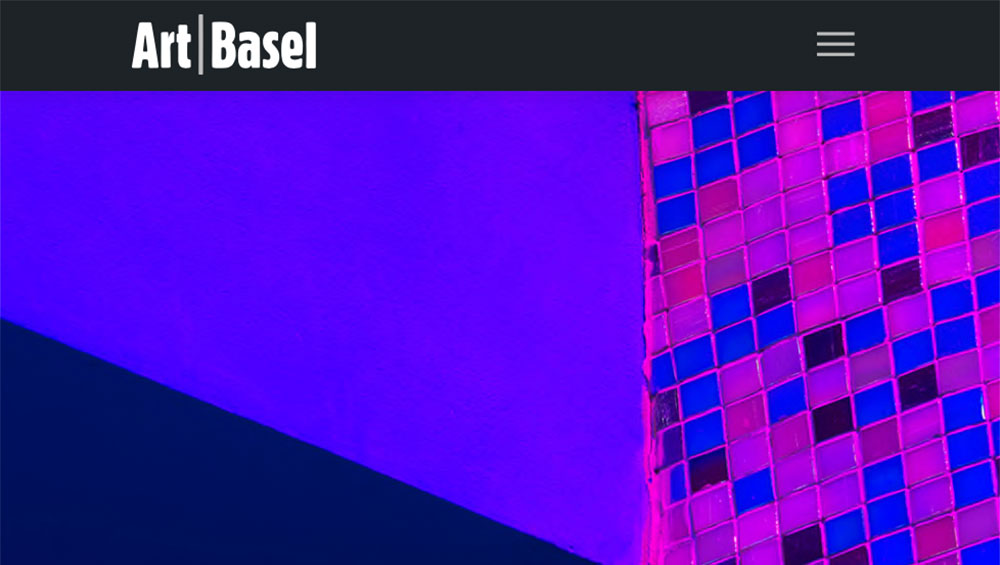
OVR 2020 (online viewing rooms)
2-6 December 2020
by JILL SPALDING
Officially cancelled because of Covid-19, the 19th iteration of ABMB nonetheless rose with the vigour of Lazarus on a brave, new, digitally curated, work-in-process-platform of online viewing rooms (OVRs). The Swiss organisers’ convoluted proposal, launched last spring at Art Basel, to use “proprietary technology to replicate the art fair experience online in an unparalleled virtual art fair community” translated to visiting zombie galleries in Miami from my bedroom in Manhattan. One day in, digital fair-going proved, if not a new paradigm, a tectonic shift. Call the disconnect generational – millennials have long experienced streamed art as meta – yet I receive artworks on my laptop as routinely as boxes from Amazon and still hold that art on walls and on screens are apples and oranges.
All the 2020 players were “present” – 255 galleries from 30 countries, with 26 newly signed on – and local visitors could attend a reduced number of tangential in-person events. The ABMB stage, though, was my laptop, and the high cost of bandwith usage had restricted each gallery to 10 artworks – a constraint circumvented by bespoke websites with varying success. In contrast to a physical fair, where booths are built like parallel envelopes, opening to different work but aligned by the same walls and floors, the posted offshoots of browsing, conversations,and comments so radically differed the virtual spaces as to inadvertently rank the artworks presented. Some dealers opted just to caption artist, medium, date and price. Others attached fish-eye views of the home gallery’s identical physical installation, flanked by staff to convey scale. The more sophisticated formula of digitally curated tours might have worked – though technical proficiency varied from wobbly walk-throughs to professionally staged spectacles – had presentation been all. Relying entirely on technology risked that display – as with a cool Prada interior by Rem Koolhaas – would present as product. Zoom in on it, light it, revolve it – devoid of the active participation and physical interaction of a bricks-and-mortar experience, there would be plenty of material (the new dealer-speak for “product”) but no buzz and no Art.
So it proved in the opening online hours. No crush of limousines spilling out big-name collectors. No VIP first-view frenzy. There was a starting bell of sorts – at 11am on 2 December, digital screens let the VIPs “in” – but gone were the advisers pattering behind collectors vying to get fresh work. Gone the buzz of: “What did you buy?; I have three works on hold; I’ll take it if you don’t!” Gone, the waterfall-hair girls on record-high heels snapping selfies in front of record-priced work. And although I didn’t miss the challenge of mapping out the gallery aisles, I was thrown by having no map at all – cast loose and invisible among fellow fairgoers.
Replacing aisles, arrows pointed out categories: galleries, artists, sectors. Substituting the buzz of coffee for crowds, I started out. Ten minutes in, I reached for more coffee. Entering the OVR site was a breeze, but when the adrenaline wore off, I would click the wrong button to move on and exile myself – a wanderer in a foreign land of unfamiliar directives – until random clicking and a robot-dialogue with the virtual VIP help desk got me back. As to exploring a virtual booth, I hold with the luddites: show me physical art that will stop me in my tracks. Even knowing that no one was waiting for me to move on, letting me linger before an image, I found myself clicking at speed-dating pace past more than 2,400 works.
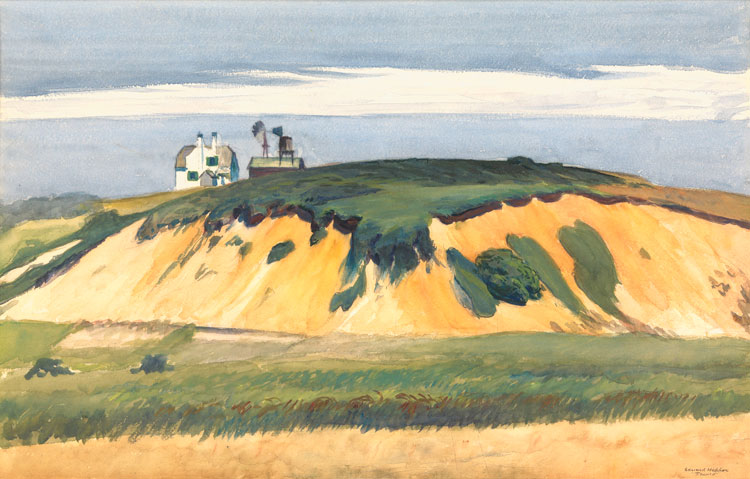
Edward Hopper’s Dune with Green Top, 1930, from Menconi + Schoelkopf’s Art Basel OVR: Miami Beach 2020 presentation. Image courtesy Menconi + Schoelkopf.
Drilling down, what worked and what didn’t? My quick run-through provided rich teaching moments – I wouldn’t have grasped the influence of Edward Hopper on David Hockney had I not flashed by the landscapes posted by Menconi + Schoelkopf and the Gray gallery – but proved mind-numbing. More problematic was the challenge of navigating varying digital platforms, like being handed differently-shaped racquets for the same ball game. Entering viewing rooms at a click made visiting easy but, although the site’s ad hoc locator listed the galleries in alphabetical order, they weren’t posted alphabetically, leaving me to start at the top and scroll down again to locate a specific one when I clicked the wrong icon. Verging on intolerable, my password expired on day one, then again on day two, and several of the new ones emailed by the VIP team didn’t work.
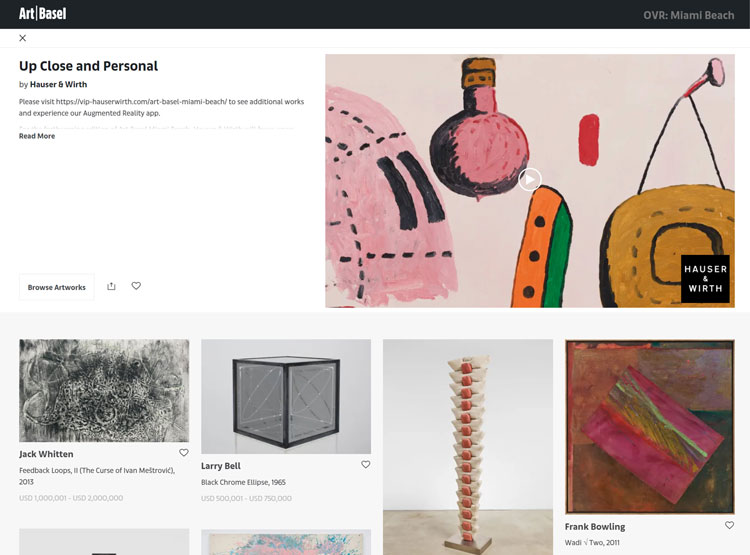
Hauser & Wirth, Art Basel Miami Beach, OVR2020, screenshot.
Worse was my dialogue with the art. With too few exceptions, computer-viewing so flattened colour and contours that, although I saw a work, I never “experienced” it. The sculpture read as works-on-paper; installations involving multiple materials read as uniform, and screen glare faded the drawings. Cruising through Hauser & Wirth’s star-studded stable, I would have paused before the Zoe Leonard drawings series had the image been decipherable. (Kudos, though, for “bringing” controversial Philip Guston material in the charged climate that postponed last month’s four-museum exhibition.)
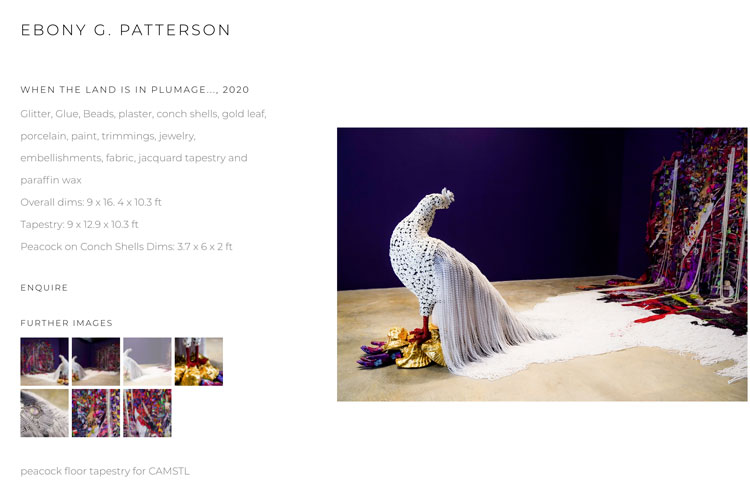
Ebony G Patterson, When the Land is in Plumage..., 2020. Monique Meloche, Art Basel Miami Beach, OVR2020, screenshot.
Textiles, unless elaborately lit, as with Ebony G Patterson’s radiant installations at Monique Meloche, showed the least well. Rosie Lee Tompkins’s dazzled quilt at Anthony Meier Fine Arts Wallen Mapondera’s elaborate wall hangings at Smac Art lacked texture, and even beadwork at the level of Myrlande Constant’s brilliant icons at Central Fine looked like decoration.
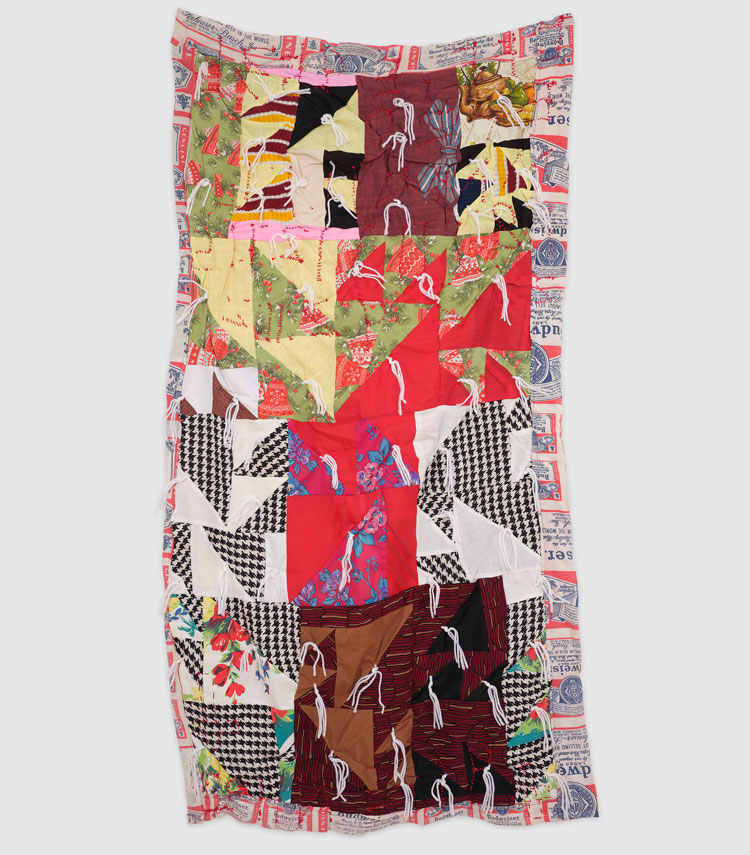
Rosie Lee Tompkins, Untitled, c1974. 62 1/4 x 34 3/4 in (158.1 x 88.3 cm). Image courtesy Anthony Meier Fine Arts.
Colour-saturated paintings stood out but, lacking depth, impacted less than figurative work with a story to tell. Ceramics fared well and the neon pieces better, but the only medium that felt actual (being itself flat) was photography. On point was South African visual activist Zanele Muholi’s powerful Self-portrait With Camera, reflecting in its lens the primal tribal fear of an instrument that swallows the soul.
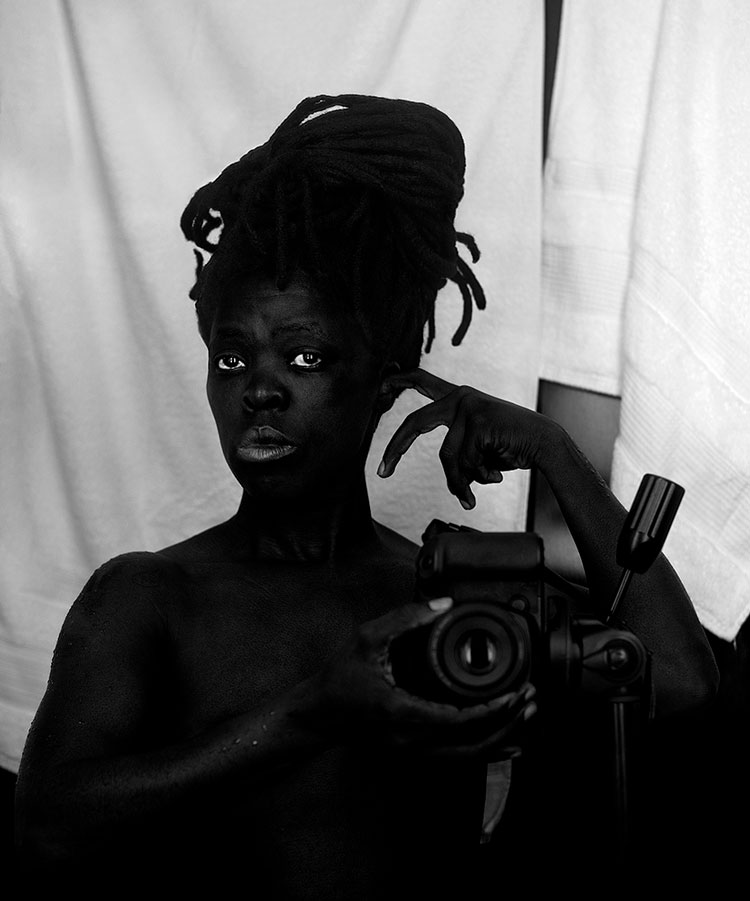
Zanele Muholi. Owake X, Sheraton, Brooklyn, New York, 2019. Gelatin Silver Print, image and paper size 23 5/8 x 15 3/4 in. Image courtesy Yancey Richardson.
Happiest on my screen was the digital material, ranging from timed walk-throughs of the viewing rooms to studio videos compiled by the artist (as asked of Marina Abramović by Galerie Krinzinger), to riveting video art (at Fortes D’Aloia & Gabriel, the addictive ants-make-art pavane by Rivane Neuenschwander and Cao Guimarães).
Presentation skills moved the needle. The most accomplished was the David Zwirner gallery’s debut, Miami/NY, a polished hired-out hybrid online/offline webcast consisting of a physical installation in the New York gallery and, on ABMB preview day, interactive discussions with the gallery directors about the artworks live-streamed on both the gallery and fair websites. Online interaction worked well when rehearsed and polished. No longer satisfied with being told to just look at art, collectors now want detailed information about the artist, materials, technique, and sales. But glitches abounded and the “live chat” option was a turn-off – hostage to sidebar comments at the level of “Wow, how did she do that?” and “Gee, gorgeous!” While indisputably proficient at showcasing “material”, even the bells and whistles technology available to the mega-galleries has a long way to go to relay the nuance, texture and heft that tremble the heart.
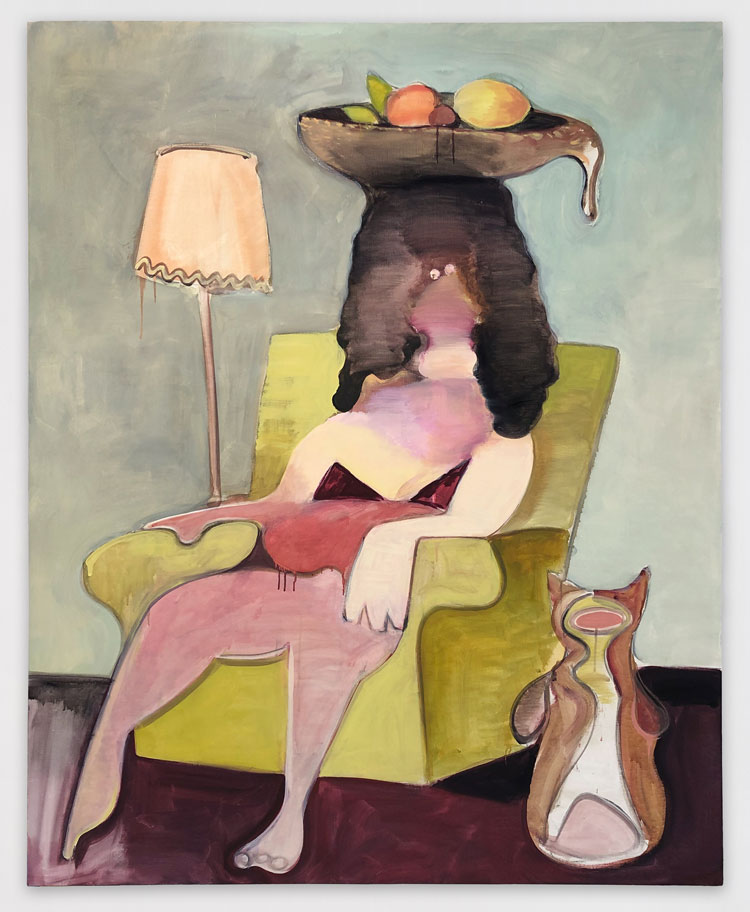
Tomoo Gokita, Future Days, 2020. Acrylic on canvas, 63 3/4 x 51 3/8 in. © Tomoo Gokita, Courtesy of the artist and Blum & Poe, Los Angeles/New York/Tokyo.
On the plus side, collectors have access to increased information about gallery inventory, can better track sales and, on sophisticated webinars, dialogue with the artists and curators. Digital viewing has given the rest of us a new tool to facilitate the spot-and-slot game of what’s new and what’s trending. Gleaned from my run through the viewing rooms: in painting, the takeover of figurative narration from conceptual work; in focus, a pivot from Chinese to Japanese artists, flagged at Blum & Poe by a fanciful Tomoo Gokita portrait. Climate concerns brought a terrific video of Alberto Baraya walking us through artificial landscapes and plants drawn from previous centuries’ western-inflected scientific explorations; on the lawn of the Bass museum, an ambitious sculptural statement (Agua Dulce) by Abraham Cruzvillegas built of thousands of plants, and scattered across greater Miami, William Cordova’s AIM Biennial project, siting installations by 78 fellow artists in threatened environments.
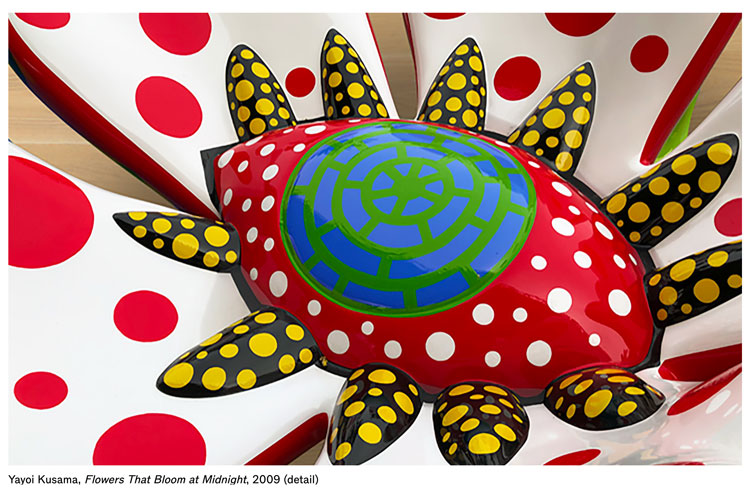
Yayoi Kusama. Flowers That Bloom at Midnight, 2009 (detail). Art Basel Miami Beach, OVR2020, screenshot.
Female artists, thankfully irrevocably transitioned from trending to mainstream, showed in virtually every space – most strongly with work by the ever-present Yayoi Kusama (dotting five galleries), Helen Frankenthaler, Louise Bourgeois, Ana Mendieta, Nan Goldin, Mary Corse, Lynda Benglis, Anicka Yi, Rachel Whiteread, Vera Lutter and Ann Hamilton – with several galleries, such as Kaufmann Repetto (posting itself as “another booth”), showing mainly women. Most engaging was the work fleshed out by guided tours (who knew that Joan Mitchell’s process might have been affected by synaesthesia?).
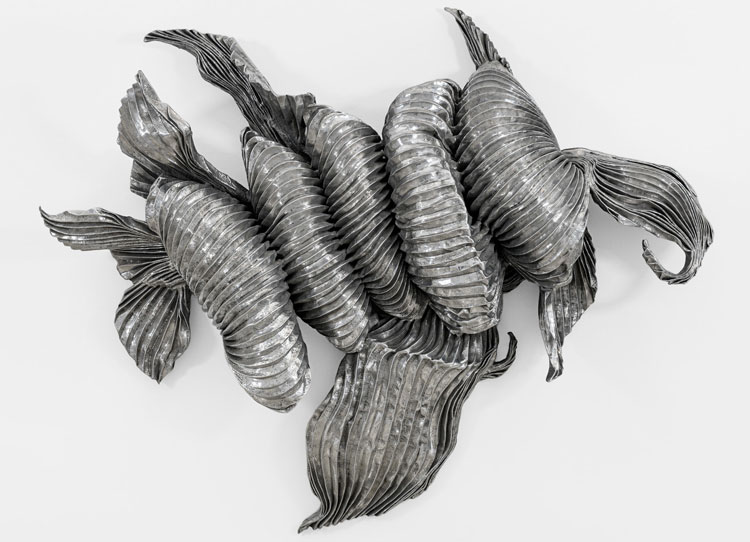
Lynda Benglis, Tempest (Juliet), 1990. © 2020 Lynda Benglis / Licensed by VAGA at ARS, NY. Image courtesy Cheim Read.
Still surging – most sold the first day – Black artists who came to fame engaging the urgent issues of racism and injustice, and lesser known ones who, lest sexual and social pain anaesthetise, have been signed on primarily for their talent. Elbowing for bandwidth alongside Theaster Gates, Henry Taylor and Simone Leigh; at Roberts Projects, strong portraits by Amoako Boafo, Dominic Chambers and – marking the power of profile – Otis Kwame Kye Quaicoe; at Karma, the outsized “bad-ass” ceramics intended to “anthropormorphise” everyday objects by Miami-born Haitian Woody de Othello.
_2020_CourtesyoftheartistandRobertsProjects-LosAngeles-California.jpg)
Dominic Chambers, After Albers (Max), 2020. Oil on linen, 60 x 60 in (152.4 x 152.4 cm). Courtesy of the artist and Roberts Projects, Los Angeles, California.
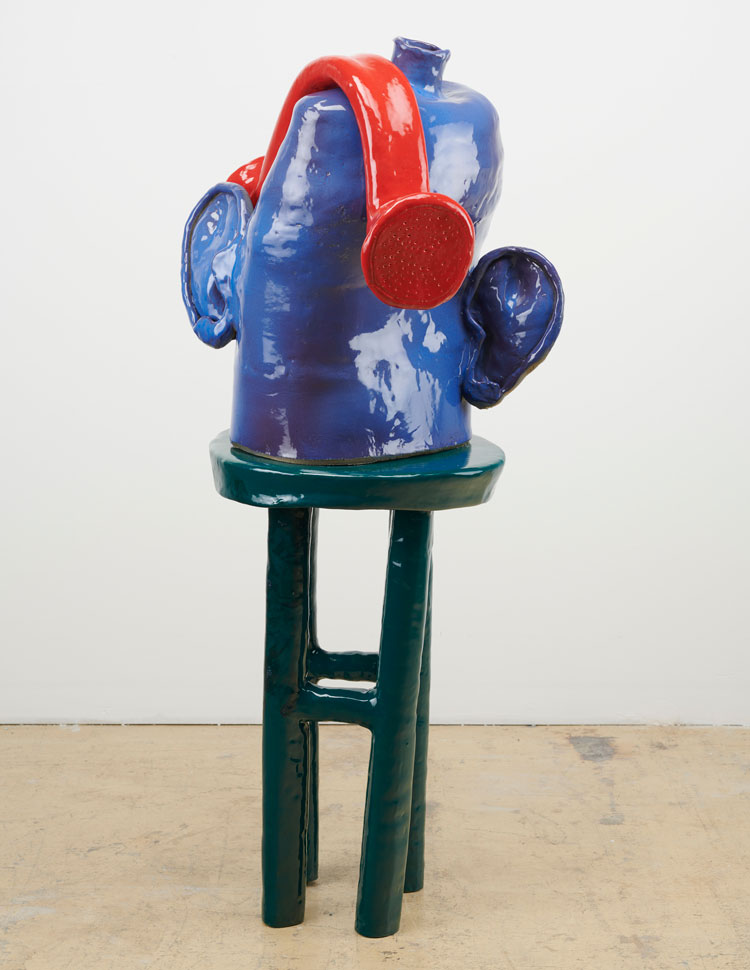
Woody De Othello, Phone Jug, 2020. Ceramic and glaze, 43 x 16 x 16 in (109 x 41 x 41 cm). Courtesy of the artist and Karma, New York.
Jack Shainman successfully paired the mid-career talent of Lynette Yiadom-Boakye with that of now top-tier Kerry James Marshall; Victoria Miro showed one of Njideka Akunyili Crosby’s new deceptively domestic scenarios alongside new work by Chris Ofili and Kara Walker.
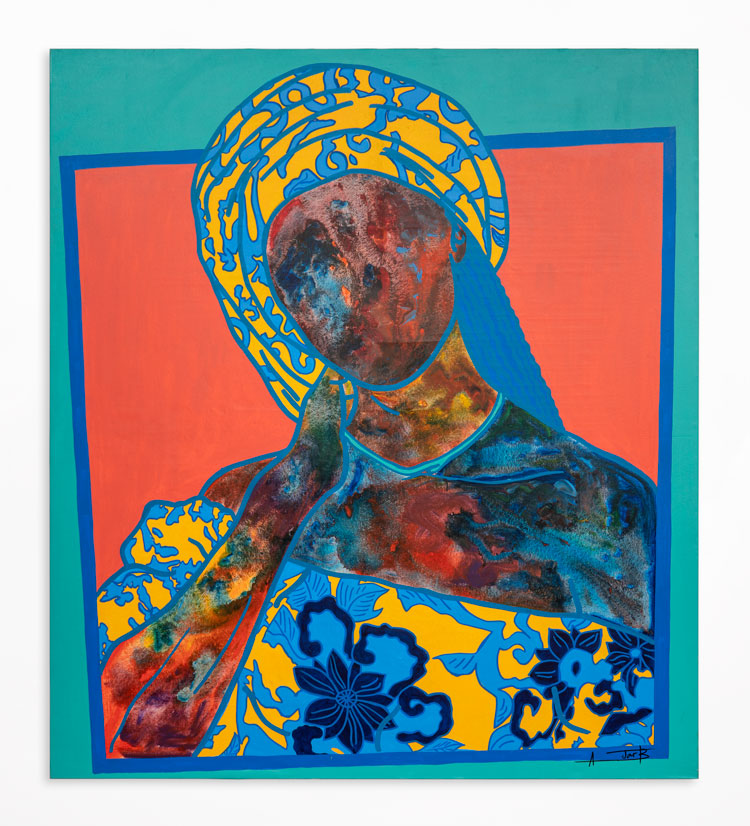
Ajarb Bernard Ategwa. Young and responsible lady, 2020. Acrylic on canvas, 78.5 x 69.5 in. Image courtesy Fredric Snitzer Gallery.
Fredric Snitzer presented a vivid chronicle of everyday life in Douala by Ajarb Bernard Ategwa (sold to Jorge Pérez of the eponymous museum), a Cameroonian sign painter in the pop artist tradition. Emblematic of a still deeper commitment, David Zwirner’s online showing of Noah Davis prefaced the exhibition programme planned for his forthcoming gallery in New York, run by Ebony L Haynes and an all-Black staff.
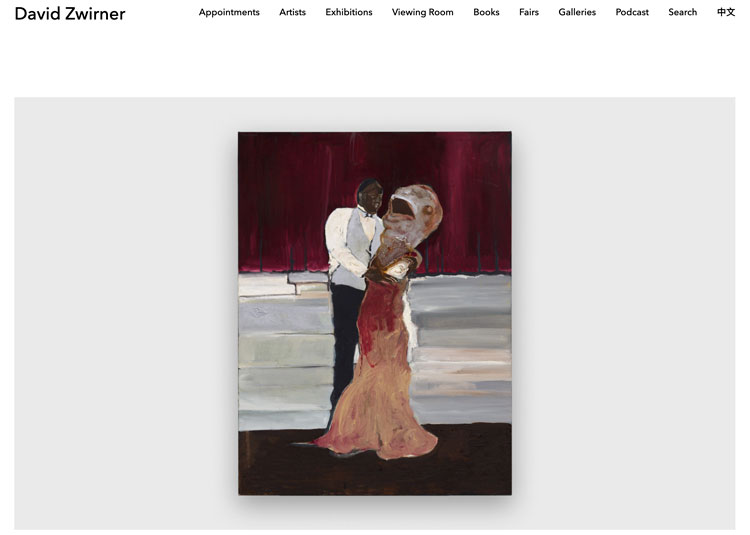
Noah Davis. Winter Formal, 2008. Oil and acrylic on canvas, 40 1/4 x 30 1/8 in (102.2 x 76.5 cm). David Zwirner, Art Basel Miami Beach, OVR2020, screenshot.
A welcome link to room categories brought up North America, Europe, Latin America, MENA (a mystery nation responding “sorry we couldn’t find any results matching your criteria”), Asia Pacific, Sub-Saharan Africa and (no other place to list it) Solo Presentation. I might otherwise have missed the terrific video by Kei Imazu and Bagus Pandega wandering me through metaphors of decay with work installed in an abandoned shopping mall in Bandung, and Santiago Mostyn’s gripping photo-essays at Andréhn-Schiptjenko.
Clicking on sectors, I found all worth a visit – Nova for the self-taught painter Greg Breda (his entire show at Patron sold out), and Survey for the Hales Gallery’s presentation of a politically charged moment in New Delhi photographer Sunil Gupta’s career portraying queer identity.
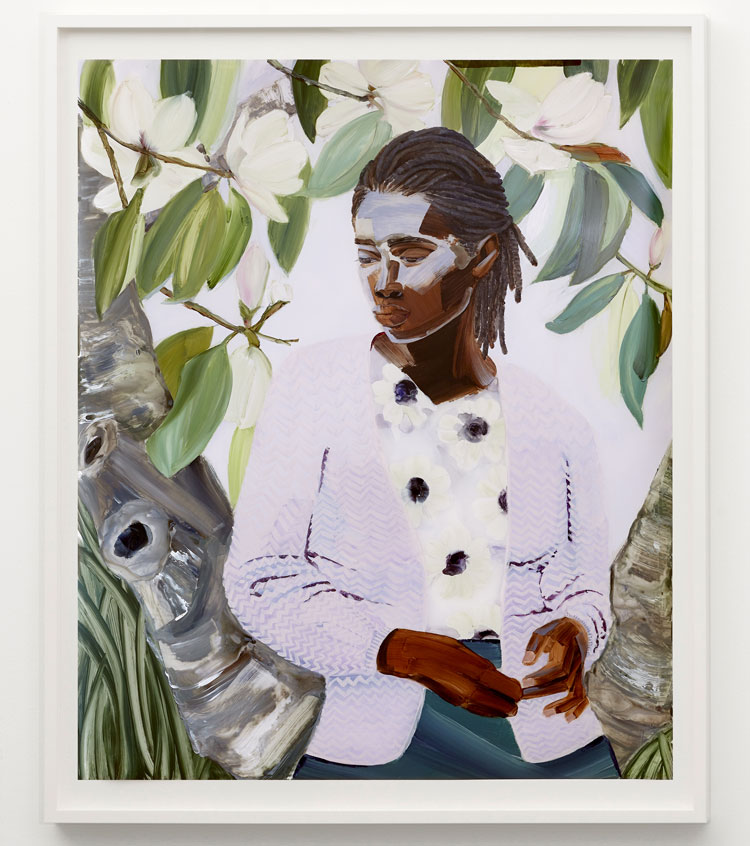
Greg Breda, Lifting Gravity, 2020. Acrylic on vellum, 45 5/8 x 38 5/8 x 2 1/8 in. Courtesy of the artist and PATRON Gallery, Chicago.
Visiting the satellite fairs brought home the meaning of “reduced edition”. With more than half cancelled, and the survivors restricting the number of artworks per gallery, expectations were low. Still, visitors flocked to Prizm to view artists influenced by Black Diaspora cinema, and both Untitled and Scope, whose presentations varied from shaky to slick, reported a flurry of sales. “Opened” two days early, the scrappy, non-profit New Art Dealers Alliance reported brisk sales of medium-priced work – one painting by the mid-career Greek artist Panayiotis Loukas at Nicelle Beauchene on hold and another sold right out of the gate.
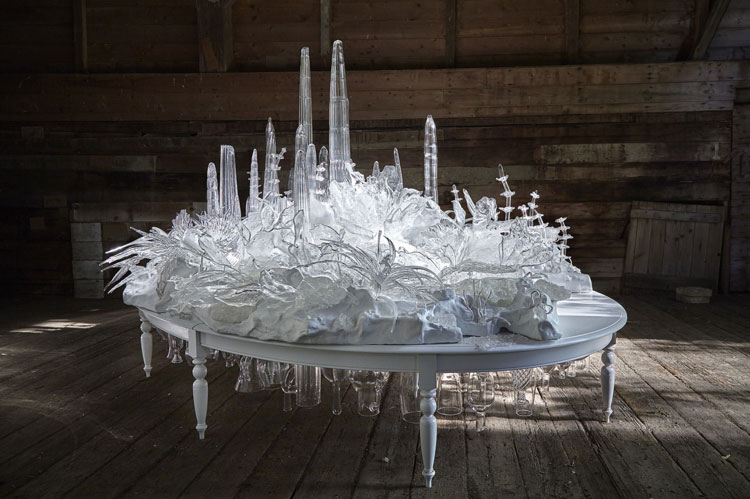
Beth Lipman. All in All, 2020. Glass, wood, clay, metal, paint, adhesive, 74 × 134 × 92 in (188 × 340.4 × 233.7 cm). Courtesy of Nohra Haime Gallery.
At Art Miami, the Nohra Haime gallery reported one piece sold and one on hold for a museum from the accomplished presentation of glass artist Beth Lipman’s lavish assemblages, timed to her current show at the museum of Art and Design. The Design Fair, by all accounts, had a well-attended in-person opening, but launched online with a shaky curatorial tour: at the description of a table, my screen showed a chair; unless the camera zoomed in on an object, the texture and materials read poorly; and a technical glitch bypassed the two ballyhooed fossilised dinosaurs (price estimate in the millions), though the link to each item’s price and details functioned perfectly. More successful, the supremely accomplished in-person and online viewing of the neighbouring Deitch/Gagosian exhibition, and David Castillo’s well-lit physical space detailing Vaughn Spann’s abstract, stained-glass-inflected, Chapel Paintings (all sold).
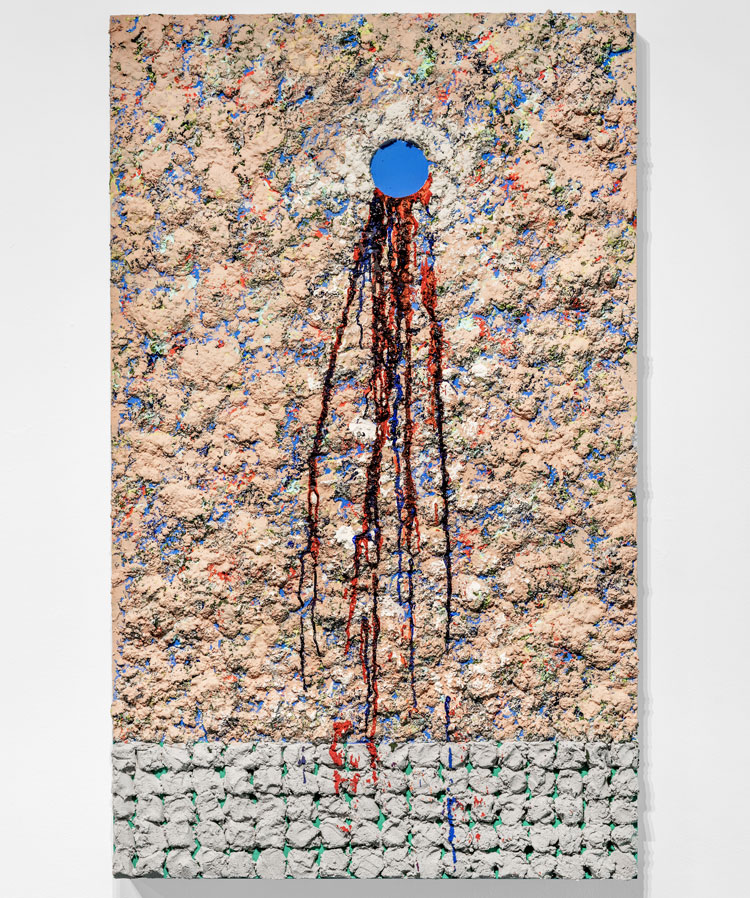
Vaughn Spann, the prophets bear witness, 2020. Courtesy the artist and David Castillo. Photo by Zachary Balber.
And what of the players? It was the artists’ moment, so the featured locals were out and about, but how did the virtual participants feel? Dorothea Rockburne, still working on “non-theory”, but now with sculpture, is pleased to be showing at ABMB OVR, but still holds to receiving visitors (two at a time) at her New York studio to view work-in-process for her upcoming in-person solo show at David Nolan: “I feel like a dinosaur. There are many things to be said for entering a calmer world. I’m no longer bound to endless emails, and parties I had felt obliged to attend. But we’re here for a reason, and the reason is people. Online is good, but I’m missing the art community, the interchange and the humour.”
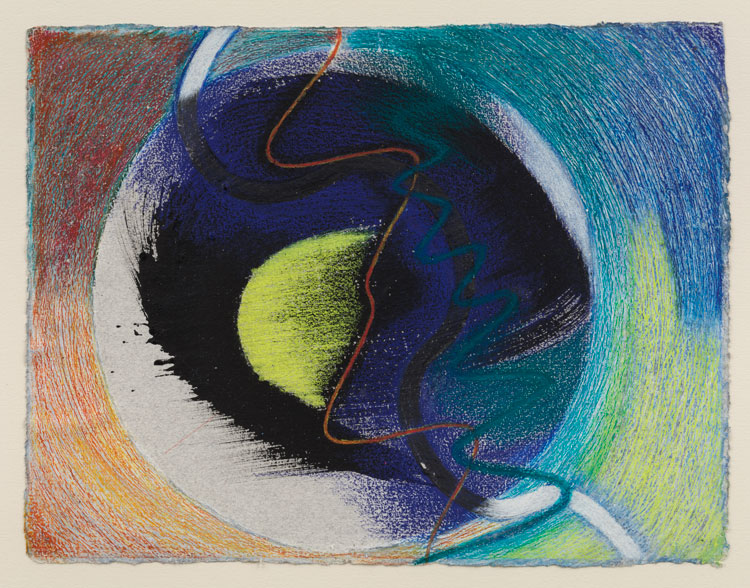
Dorothea Rockburne. Particle and Wave, 1994. Flashe paint and watercolour sticks on handmade paper, image: 9 1/2 x 12 1/2 in (24.1 x 31.8 cm), sheet: 19 1/2 x 24 3/4 in (49.5 x 62.9 cm). Image courtesy David Nolan Gallery.
What, too, of the buyers and sellers who sustain an art fair? How well did virtual fair-going work for them? Is this a watershed moment? Might collector fair-fatigue, already palpable since 2016 and compounded by a platform grown too demanding and expensive, now move all viewing and transaction online? Although private sales abounded at ABMB, elsewhere they were down. Of attending online, the collectors I spoke to (all off the record) who had not pre-purchased a work they had been “promised” or were “waiting for” were “not motivated to clock in at the opening bell”, “not inspired to buy art in my pyjamas”, liked “running through what’s going on in the art world”, but “never paused in front of a particular piece”, would “never buy a work online”, and thought, “it all looked the same”, “began to blur”, or “couldn't make out the material.” All missed the direct contact with dealers and fellow collectors, but none regretted the “promo-bashes” and “just-one-more” after-party – notably absent this year, with the exception of the happy divorcee Libbie Mugrabi’s feckless A-list invitation to a dinner at the Faena Hotel intended to preempt Aby Rosen’s annual “It” fest.
It turned out, however, that my sampling was as accurate as our election polls. Fredric Snitzer, Miami’s storied dealer (and the only one on the ABMB selection committee), had zero expectations of a virtual viewing room, so set up a physical iteration of it at his gallery then sold like wildfire from the fair. “I was shocked! All of our artists sold – there was so much pent-up energy from collectors confined by the pandemic that we had tons of inquiries. The Instagram response alone was unbelievable. What’s astonishing is the cachet of the Art Basel brand. Even their online presence is so valuable that we were getting responses from all over the world – China, Latin America, Africa, everywhere!” No need then to go back to bricks and mortar? “It won’t matter. The Art Basel brand is so powerful, it carries so much weight and energy, that whether the fair is in the convention center or online, I want to be there.”
And what did fellow dealers think? Six conversations with the 30-plus I spoke to said it all. While collectors, reported Stephen Truax of Cheim Read (having just sold a $175,000 Barry McGee), liked the convenience of viewing so much work online, and welcomed the ease of purchase and delivery effected by the galleries’ bespoke websites, he doesn't see an OVR fair as the way of the future.
In contrast, New York photography dealer Yancey Richardson, first-time presenter at ABMB, was unfazed; “These days people are looking extensively online. So many clients are not local or can’t come to the fairs that we always email work to them before openings, and provide a rich experience by attaching links to viewing rooms, pdfs, a film or an audio component. For Art Basel 2020, we showed only work made this year. Wanting to keep it tight for ABMB we chose three strong artists – Zanele Muholi, Mickalene Thomas, and David Alekhuogie.” Not irrelevant is that the first has a major UK survey scheduled this month at Tate Modern, the second has a solo show taking over the Bass Museum for the second year running, and the third showed in this year’s iteration of MoMA’s New Photography exhibition.
Showing here at Untitled, Christine Wächter-Campbell (of the seminal West Chelsea Winston Wächter gallery) sees the new platform as an opportunity: “A silver lining. Once I got over the shock, and the panic of how to keep all employed, I went back to the drawing board and completely revamped and upped my virtual presence to make the presentation look polished. To convey a physical visual and sensory experience, you’re not going to show digital work, for example, because it requires another access link and more time spent in front of the computer screen. Concurrent with our in-person, 10-at-a-time, gallery show of Peter Gronquist, we’ve been posting online exhibitions or even a single, fresh-from-the-studio, work. For Untitled, I had to curate the booth differently, choose work that presents better online, and monitor it with a very small staff.”
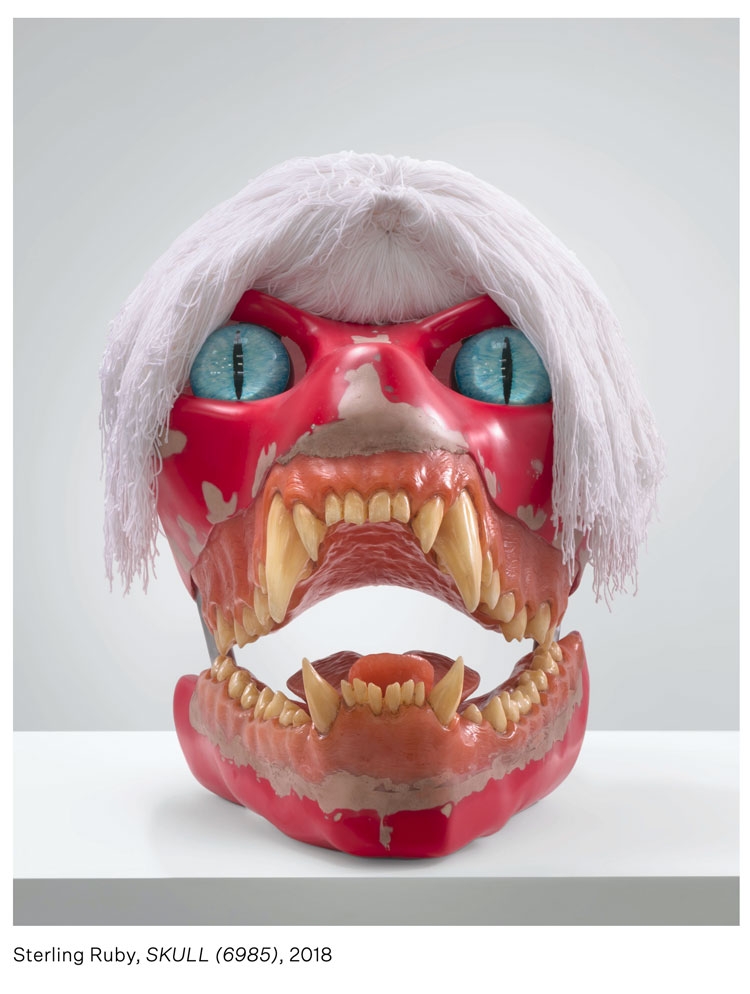
Sterling Ruby, SKULL (6985), 2018. Screenshot, The Future, presented by Gagosian and Jeffrey Deitch.
Jeffrey Deitch, enfant terrible of the once-stuffy art world and now guardian at the gate of closely curated, in-depth, exhibitions, says that, allaying his fears of a market collapse, between the non-stop in-person traffic at his NY gallery and Zoom calls all over the world, he has never been busier. “Collectors invested in buying have more time to pursue art. They’ve been calling since May, asking: ‘Anything interesting? What do you have for me?’ Yes, it’s not like a seeing a work, but if you like an artist, know the dealer, and are shown jpegs of well-lit work photographed closeup and scaled as we do it by placing a staff member in front of it, you’ll buy it.” Resolved to continue the “important tradition” of teeming up annually with Larry Gagosian to stage a provocative exhibition in the Miami Design District, although neither he nor Larry would be physically present this year, Deitch took advantage of storefronts emptied for redevelopment to rent a large one for the purpose (as has Mitchell-Innes & Nash and Lévy Gorvy) and shipped enough material to extend the in-person show well beyond the five-day fair parameter. Themed to Ed Ruscha’s signature The Future, and helmed by Miami native Kenny Scharf, works by a roster of 60 artists including Jeff Koons, Damien Hirst, Urs Fischer and – follow her – the star-is-born hyperrealist Ariana Papademetropoulos, are paired with a 24/7 online show designed by a London “webmaster, one of the best in the world” – a formula Deitch believes will work for the actual future.
Mega-dealer Sean Kelly was more upfront. “We’re nine months into virtual viewing and anyone who says it’s better than a real fair is lying. Yes, it’s less stress for the dealers, the wear and tear of travel and the cost of shipping, travel, booths, hotels and entertaining was getting out of hand. But they have to perfect the online experience. They’re just not there yet – they still have to figure out how to convincingly convey texture and scale. The issue at this time is that there’s no viable alternative.” How have their clients responded? “Honestly, while at a bricks-and-mortar fair they buy on impulse in the heat of the moment, unless it’s something wonderful from an established artist, or something low-priced from a young artist, even seasoned collectors are just not that comfortable buying work online without seeing it. Still, we’ve made every effort to bring fresh inventory, like the Idris Khan and the work we commissioned from Kehinde Wiley. And, what none of us could have predicted after this huge outpouring of trepidation, is that the market has proved extraordinarily resilient. It’s still very slow, but good material is selling. So, economically, the estimated 40% savings in the cost of mounting a booth, not to speak of the stress, has caused a lot of us to question whether it’s worth it. We’ll be considering very carefully which fairs to attend going forward. The formula is still being worked out.”
As is that of the sponsors. The virtual art fair’s bete noire (Kelly was alone in fingering it) is bandwidth. Constructing it is costly and, since there is only so much room in the “tunnel”, the viewing rooms are restricted. With the organisers still struggling to provide a viable platform, the galleries were charged an across-the board nominal fee – clearly unsustainable down the line.
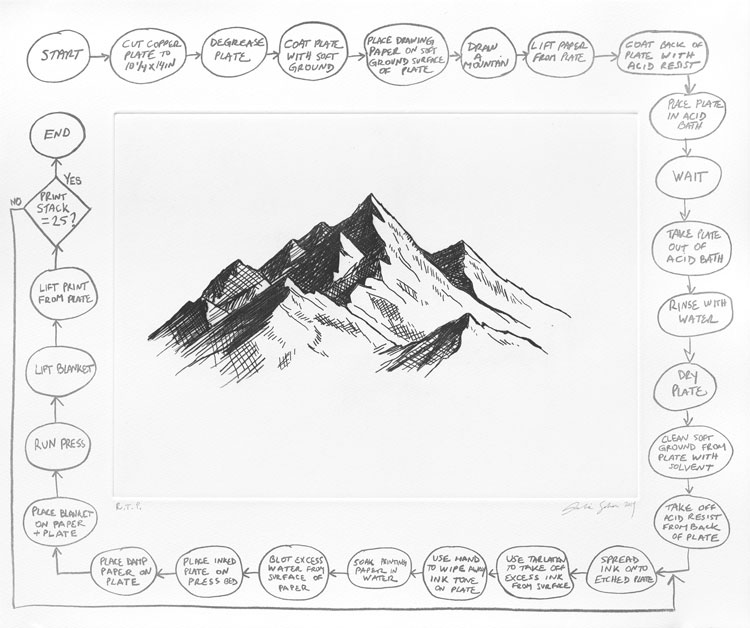
Analia Saban, Flowchart (Mountain), 2020. Two-colour etching, 16 5/8 x 19 7/8 in. © Analia Saban and Gemini G.E.L.
My takeaway? I felt I had got my ticket’s worth, was grateful for the travel money saved and liked knowing I had not missed out on what’s happening. The bottom-line question – would I rather not have “attended”? – has been answered by the number of artworks still floating in memory. And all the aggro was forgiven when I stumbled on videos of an artist’s practice: the quietly addictive rollout of conceptual artist Analia Saban’s new series of drawings at Gemini GEL (a step-by-step concept-within-concept that details both her process and her instructions to the printer); Mickalene Thomas, at Yancey Richardson, rolling out her materials and process then gesturing with a joy I will never forget: “The gaze in my work is unapologetically a black woman’s gaze loving other black women!” Emotion transmitted! If improved technology can deliver the emotion-key to unlock the aura of art posted online, will a virtual fair suffice?
Not so fast. Miami collector and developer Craig Robins, keeping in mind his huge stake in the famed Design District that he wrested from a backwater, sees this moment more as an acceleration of the direction things were already going in – a “very, very long shift toward total freedom. People will realise they don’t have to travel as much to have an ongoing dialogue with art.” Why, then, has he kept his collection in the Dacra building open for viewing all summer and curated an in-person show for ABMB week? “People still want to have a physical experience, which is why every store in the Design District has remained open since March for – as it has proved – vigorous business. To penetrate people’s brains is essential to marketing.”
And there you have it, bricks and mortar plus digital. Going forward, Gen Z brains may well be penetrated by a Google Glass type of virtual presentation, and the stress, expense and urgency to attend in person will no doubt diminish the number of global art fairs, but the across-the-board anticipation of ABMB 2021 returning to the convention center speaks to an art world still invested in physical immersion. Ever uppermost, too, is the collective understanding that on-site art fairs are a deep part of the economy – tourism, real estate, hotels and restaurants all depend on it – a minimum $6m lost to the Miami bloodstream this year – an incalculable loss for new Art Basel partner James Murdoch.